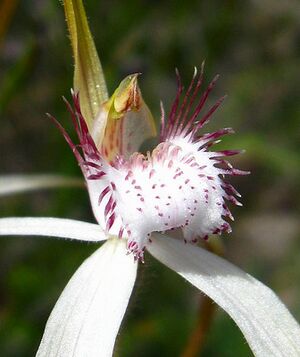Coastal white spider orchid facts for kids
Quick facts for kids Coastal white spider orchid |
|
|---|---|
 |
|
| C. longicauda subsp. calcigena growing in Perth | |
| Scientific classification |
|
| Kingdom: | Plantae |
| Clade: | Tracheophytes |
| Clade: | Angiosperms |
| Clade: | Monocots |
| Order: | Asparagales |
| Family: | Orchidaceae |
| Subfamily: | Orchidoideae |
| Tribe: | Diurideae |
| Genus: | Caladenia |
| Species: | |
| Subspecies: |
C. l. subsp. calcigena
|
| Trinomial name | |
| Caladenia longicauda subsp. calcigena Hopper & A.P.Br.
|
|
| Synonyms | |
|
Arachnorchis longicauda subsp. calcigena (Hopper & A.P.Br.) D.L.Jones & M.A.Clem. |
|
The coastal white spider orchid (scientific name: Caladenia longicauda subsp. calcigena) is a special type of plant. It belongs to the amazing orchid family. This orchid is found only in the south-west part of Western Australia. This means it's endemic there, like a unique treasure! It has one fuzzy leaf and usually up to four mostly white flowers. You can find it growing in sandy areas along the coast. It stands out from other similar orchids because of its longer sepals and petals, a small, narrow labellum, and the unique pattern of its calli.
What it Looks Like
The coastal white spider orchid is a ground-dwelling plant. It's a perennial herb, meaning it lives for more than two years. It's also deciduous, so it loses its leaves at certain times. This plant has an underground tuber, which is like a storage organ, and one hairy leaf. The leaf is about 8 to 12 centimeters (3 to 5 inches) long and 8 to 12 millimeters (0.3 to 0.5 inches) wide.
It grows up to four mostly white flowers on a tall stem. The stem can be about 25 to 40 centimeters (10 to 16 inches) high. Each flower is quite large, measuring about 10 to 15 centimeters (4 to 6 inches) long and 3 to 8 centimeters (1 to 3 inches) wide.
The lateral sepals (the side parts of the flower that look like petals) and the petals (the true petals) have long tips that hang down. The dorsal sepal (the top part) stands upright. The labellum (the orchid's special lip) is mostly white. It's about 1.6 to 2.2 centimeters (0.6 to 0.9 inches) long and 0.7 to 1 centimeter (0.3 to 0.4 inches) wide. The labellum has long, narrow teeth along its sides.
In the center of the labellum, there are four or more rows of pale red calli. These are small bumps or structures. Near the tip of the labellum, these calli become very close together and are arranged in a messy way. This orchid blooms, or flowers, from September to October.
How it Got its Name
The main species, Caladenia longicauda, was first officially described by a botanist named John Lindley in 1840. This description was published in a book called A Sketch of the Vegetation of the Swan River Colony.
Later, in 2001, two other botanists, Stephen Hopper and Andrew Brown, described eleven different types, or subspecies, of this orchid. One of these was our coastal white spider orchid, subspecies calcigena. Their descriptions were published in a scientific journal called Nuytsia.
The subspecies name calcigena comes from two Latin words. Calx or calcis means "lime," and -genus means "born or produced in a certain situation." This name refers to the limestone soils where this special orchid likes to grow.
Where it Lives
The coastal white spider orchid grows in a specific area of Western Australia. You can find it between Bunbury and a place called Cliff Head, near Dongara. It lives in areas with woodlands and heath, which are types of shrubland. It prefers sandy soil that is found over limestone rock.
Looking After This Orchid
The Western Australian Government's Department of Parks and Wildlife has classified Caladenia longicauda subsp. calcigena as "not threatened." This is good news, meaning it's not currently at risk of disappearing.


